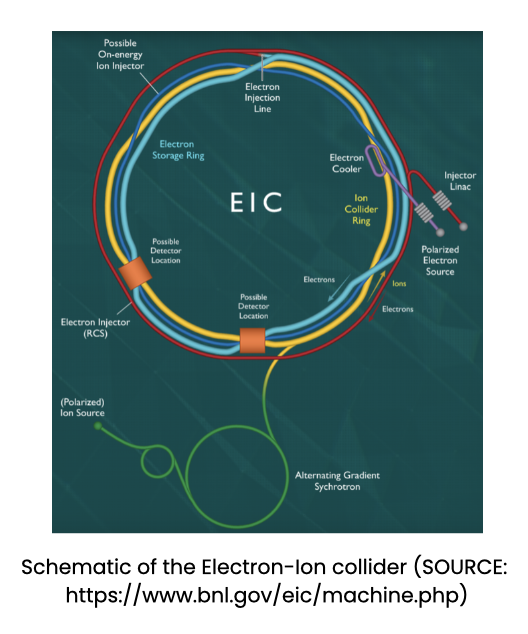The Electron-Ion Collider (EIC) is a major new accelerator facility to be built at the Brookhaven National Laboratory (BNL) near New York, USA. It will be the world’s first polarized electron-proton collider where both the electron and proton beams have their spins aligned in a controllable way. The electron beam will reveal the arrangement of the quarks and gluons that make up the protons and neutrons of nuclei. Data-taking is expected in the early 2030’s.
The EiC will be a discovery machine for understanding Quantum Chromodynamics (QCD), the theory of the strong interaction between quarks mediated by gluons, and for studying the structure and dynamics of matter at high luminosity, high energy and with a wide range of nuclei. In particular, the experiment will be able to address how the proton gets its spin, how hadrons acquire their mass from quarks that are almost massless, how gluons prevent quarks from being observed as free particles and establish whether there are emergent forms of matter made of densely packed gluons. The EIC will have a design luminosity of 1033 – 1034 cm-2 s-1, and a centre of mass range of 20 – 140 GeV. The integrated luminosity will be 10-100 fb-1 per year. This will be approximately 100 times greater than the previous generation HERA collider at DESY, Germany.

The EiC will consist of two intersecting accelerators, one producing an intense beam of electrons, the other a high-energy beam of protons or heavier atomic nuclei. As these particles collide, the electrons will scatter off the quarks and gluons within the proton or nucleus. Studying the patterns and characteristics of the particles ejected in these scattering interactions will tease out the internal structure and distribution of the quarks and gluons.
The discoveries to be made at the EIC promise to revolutionise our understanding of the strong interaction, one of the four fundamental forces of nature, which governs the behaviour of atomic nuclei and accounts for more than 99% of the visible mass of the Universe.
The ePIC Collaboration and Detector
The ePIC collaboration was formed to design, build, and operate the first experiment at the EiC. The detector is currently in its design phase. The detector has a cylindrical volume about 9.5m longitudinally and 3m radially, covering an acceptance of about 3°-177°. The transverse momentum of charged particles is measured by reconstructing their trajectory. This is achieved through the ePIC tracking system, consisting of state-of-the art silicon and micro-pattern gas detectors, instrumented within a 1.7T magnetic field. A combination of electromagnetic and hadron calorimeters measure the energy that particles deposit as they leave the ePIC detector. Finally, to identify the type of particle being detected, a set of fast timing and Cerenkov based particle identification detectors are implemented.

3d rendering of the planned ePIC detector
PPD will be involved in the design, construction and installation of the two outer layers of the silicon vertex tracker (SVT) Outer Barrel (OB) at the very heart of the ePIC detector. The ePIC SVT is composed of detectors leveraging state-of-the-art 65nm technology wafer-scaled stitched MAPS silicon sensors. The SVT consists of three vertex inner layers, two barrel outer layers, and five disks in both the electron and hardon going directions. The silicon detectors cover roughly 7.5 m2.

ePIC detector schematics (left), outer barrel is highlighted on the right. Two outer most layers of the Silicon Vertex tracker, labelled 'SVT endcaps' are currently being designed by members of PPD and colleagues in the technology department.
